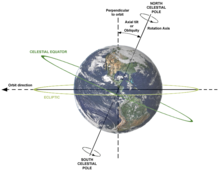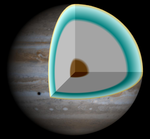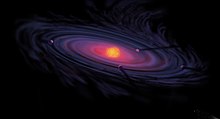Dynamic characteristics
Orbit

The orbit of the planet Neptune compared to that of Pluto. Note the elongation of Pluto's orbit in relation to Neptune's (eccentricity), as well as its large angle to the ecliptic (inclination).
Each planet's orbit is delineated by a set of elements:
- The eccentricity of an orbit describes how elongated a planet's orbit is. Planets with low eccentricities have more circular orbits, while planets with high eccentricities have more elliptical orbits. The planets in the Solar System have very low eccentricities, and thus nearly circular orbits. Comets and Kuiper belt objects (as well as several extrasolar planets) have very high eccentricities, and thus exceedingly elliptical orbits.
- The semi-major axis is the distance from a planet to the half-way point along the longest diameter of its elliptical orbit (see image). This distance is not the same as its apastron, as no planet's orbit has its star at its exact centre.
- The inclination of a planet tells how far above or below an established reference plane its orbit lies. In the Solar System, the reference plane is the plane of Earth's orbit, called the ecliptic. For extrasolar planets, the plane, known as the sky plane or plane of the sky, is the plane of the observer's line of sight from Earth. The eight planets of the Solar System all lie very close to the ecliptic; comets and Kuiper belt objects like Pluto are at far more extreme angles to it. The points at which a planet crosses above and below its reference plane are called its ascending and descending nodes. The longitude of the ascending node is the angle between the reference plane's 0 longitude and the planet's ascending node. The argument of periapsis (or perihelion in the Solar System) is the angle between a planet's ascending node and its closest approach to its star.
Axial tilt
Planets also have varying degrees of axial tilt; they lie at an angle to the plane of their stars' equators. This causes the amount of light received by each hemisphere to vary over the course of its year; when the northern hemisphere points away from its star, the southern hemisphere points towards it, and vice versa. Each planet therefore possesses seasons; changes to the climate over the course of its year. The time at which each hemisphere points farthest or nearest from its star is known as its solstice. Each planet has two in the course of its orbit; when one hemisphere has its summer solstice, when its day is longest, the other has its winter solstice, when its day is shortest. The varying amount of light and heat received by each hemisphere creates annual changes in weather patterns for each half of the planet. Jupiter's axial tilt is very small, so its seasonal variation is minimal; Uranus, on the other hand, has an axial tilt so extreme it is virtually on its side, which means that its hemispheres are either perpetually in sunlight or perpetually in darkness around the time of its solstices. Among extrasolar planets, axial tilts are not known for certain, though most hot Jupiters are believed to possess negligible to no axial tilt, as a result of their proximity to their stars.Rotation
The planets rotate around invisible axes through their centres. A planet's rotation period is known as its day. Most of the planets in the Solar System rotate in the same direction as they orbit the Sun, which is counter-clockwise as seen from above the sun's north pole, the exceptions being Venus and Uranus which rotate clockwise, though Uranus's extreme axial tilt means there are differing conventions on which of its poles is "north", and therefore whether it is rotating clockwise or anti-clockwise. However regardless of which convention is used, Uranus has a retrograde rotation relative to its orbit.The rotation of a planet can be induced by several factors during formation. A net angular momentum can be induced by the individual angular momentum contributions of accreted objects. The accretion of gas by the gas giants can also contribute to the angular momentum. Finally, during the last stages of planet building, a stochastic process of protoplanetary accretion can randomly alter the spin axis of the planet. There is great variation in the length of day between the planets, with Venus taking 243 Earth days to rotate, and the gas giants only a few hours. The rotational periods of extrasolar planets are not known; however their proximity to their stars means that hot Jupiters are tidally locked (their orbits are in sync with their rotations). This means they only ever show one face to their stars, with one side in perpetual day, the other in perpetual night.
Orbital clearing
The defining dynamic characteristic of a planet is that it has cleared its neighborhood. A planet that has cleared its neighborhood has accumulated enough mass to gather up or sweep away all the planetesimals in its orbit. In effect, it orbits its star in isolation, as opposed to sharing its orbit with a multitude of similar-sized objects. This characteristic was mandated as part of the IAU's official definition of a planet in August, 2006. This criterion excludes such planetary bodies as Pluto, Eris and Ceres from full-fledged planethood, making them instead dwarf planets. Although to date this criterion only applies to the Solar System, a number of young extrasolar systems have been found in which evidence suggests orbital clearing is taking place within their circumstellar discs.Physical characteristics
Mass
A planet's defining physical characteristic is that it is massive enough for the force of its own gravity to dominate over the electromagnetic forces binding its physical structure, leading to a state of hydrostatic equilibrium. This effectively means that all planets are spherical or spheroidal. Up to a certain mass, an object can be irregular in shape, but beyond that point, which varies depending on the chemical makeup of the object, gravity begins to pull an object towards its own centre of mass until the object collapses into a sphere.Mass is also the prime attribute by which planets are distinguished from stars. The upper mass limit for planethood is roughly 13 times Jupiter's mass for objects with solar-type isotopic abundance, beyond which it achieves conditions suitable for nuclear fusion. Other than the Sun, no objects of such mass exist in the Solar System; but there are exoplanets of this size. The 13MJ limit is not universally agreed upon and the Extrasolar Planets Encyclopaedia includes objects up to 20 Jupiter masses, and the Exoplanet Data Explorer up to 24 Jupiter masses.
The smallest known planet, excluding dwarf planets and satellites, is PSR B1257+12A, one of the first extrasolar planets discovered, which was found in 1992 in orbit around a pulsar. Its mass is roughly half that of the planet Mercury.
Internal differentiation
Atmosphere
All of the Solar System planets have atmospheres as their large masses mean gravity is strong enough to keep gaseous particles close to the surface. The larger gas giants are massive enough to keep large amounts of the light gases hydrogen and helium close by, while the smaller planets lose these gases into space. The composition of the Earth's atmosphere is different from the other planets because the various life processes that have transpired on the planet have introduced free molecular oxygen. The only solar planet without a substantial atmosphere is Mercury which had it mostly, although not entirely, blasted away by the solar wind.Planetary atmospheres are affected by the varying degrees of energy received from either the Sun or their interiors, leading to the formation of dynamic weather systems such as hurricanes, (on Earth), planet-wide dust storms (on Mars), an Earth-sized anticyclone on Jupiter (called the Great Red Spot), and holes in the atmosphere (on Neptune). At least one extrasolar planet, HD 189733 b, has been claimed to possess such a weather system, similar to the Great Red Spot but twice as large.
Hot Jupiters have been shown to be losing their atmospheres into space due to stellar radiation, much like the tails of comets. These planets may have vast differences in temperature between their day and night sides which produce supersonic winds, although the day and night sides of HD 189733b appear to have very similar temperatures, indicating that that planet's atmosphere effectively redistributes the star's energy around the planet.
Magnetosphere

Schematic of Earth's magnetosphere
Of the eight planets in the Solar System, only Venus and Mars lack such a magnetic field. In addition, the moon of Jupiter Ganymede also has one. Of the magnetized planets the magnetic field of Mercury is the weakest, and is barely able to deflect the solar wind. Ganymede's magnetic field is several times larger, and Jupiter's is the strongest in the Solar System (so strong in fact that it poses a serious health risk to future manned missions to its moons). The magnetic fields of the other giant planets are roughly similar in strength to that of Earth, but their magnetic moments are significantly larger. The magnetic fields of Uranus and Neptune are strongly tilted relative the rotational axis and displaced from the centre of the planet.
In 2004, a team of astronomers in Hawaii observed an extrasolar planet around the star HD 179949, which appeared to be creating a sunspot on the surface of its parent star. The team hypothesised that the planet's magnetosphere was transferring energy onto the star's surface, increasing its already high 7,760 °C temperature by an additional 400 °C.
Secondary characteristics
Several planets or dwarf planets in the Solar System (such as Neptune and Pluto) have orbital periods that are in resonance with each other or with smaller bodies (this is also common in satellite systems). All except Mercury and Venus have natural satellites, often called "moons." Earth has one, Mars has two, and the gas giants have numerous moons in complex planetary-type systems. Many gas giant moons have similar features to the terrestrial planets and dwarf planets, and some have been studied as possible abodes of life (especially Europa).
The rings of Saturn
No secondary characteristics have been observed around extrasolar planets. However the sub-brown dwarf Cha 110913-773444, which has been described as a rogue planet, is believed to be orbited by a tiny protoplanetary disc.












